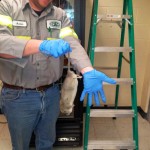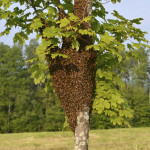
A pretty hefty roof rat picture send by Keller
ISD impressed me, but not so much the expert
from New York City.
Moby Rat – How one image spurred a blog post by Dr. Mike Merchant and email chatter with Dr. Bobby Corrigan
I can tell you that fishermen aren’t the only ones to exaggerate when it comes to biggest-catch stories. I’ve heard lots of tales. “I swear that cockroach that flew at me was 6 inches long!” “That rattlesnake was as big as my leg!” And, maybe most impressive, “The rats in our neighborhood are as big as cats!”
Nearly everyone and their brother’s got a story about the biggest rat. “Moby rats” they might be called. Or “super rats”.
A picture of one big roof rat sent recently by one our Texas school districts got me thinking. What is a really big rat? And what would it take to impress someone who has worked most of his life with rats? Someone like Dr. Bobby Corrigan, the rat expert who consults on rodent control for New York City?
I decided I would send the school picture to Bobby and see what he thought. He did not disappoint. In his methodical way, he analyzed the image, and shot back a series of questions:
- “Is that a scrotal sack under the tail, or possibly enlarged female genitalia? Hmmm…don’t see any teats.” [This blog post is going to get lots of strange Google hits]
- “Was the tail long enough to be pulled back over and beyond the head?” [Knowing what species is critical for the Guinness world record book–roof rat tails are generally longer than the body… otherwise it would be a Norway rat.]
- “How long was it dead?” “If it was dead for a few days in a ceiling,” he explained, “…the body begins to decompose, the skin gets stretchy when held by the tail, and they can appear much larger than what they really are. Too, the body gases inside will begin to bloat the cavity and the whole end result is a very large-appearing rat.” [Never thought of that!]
- Last but not least, he asked, “How much did it weigh?” [It takes more than a picture… you gotta have real data to impress a rat expert.]
Of course the upshot of all this was that I felt a little sheepish. I should have thought to ask those questions before I even sent the picture. Duh! And who knew that you could rig a big rat competition by letting Fatty stew in his own juices a few days?
My last question to Bobby was, “What would it take to impress you? What’s a really big rat?”
He answered quickly. “Any rat 2 pounds or over.” “But it has to be fresh,” he added.
According to Bobby, the heaviest live Rattus norvegicus on record is 1.8 lbs (29 oz) or about 820 g. Most “big boys” weigh in the 775 g range, he said. And according to his book on rodent control, wild Norway rats over the years have been measured up to 19 inches.
By the way, compare these stats to what might be the world’s fattest cat weighing in at 39 pounds. And an average healthy cat, I’m told, runs 8-12 pounds. No contest between rats and cats there. And chances of seeing a rat as big as a full grown cat is nil.
Of course Dr. Corrigan couldn’t leave things gentlemanly. He had to add, “Texans claims that everything is bigger in Texas. You guys should own up to the bragging.”
I’d say those are fighting words, Texas PMPs. So here’s a challenge. The next time you find what you think might be an impressive rat, check the sex and species (lots of sites online for how to sex rats), weigh it, measure the length, and take a photo and send to schoolipm@tamu.edu. If you come up with anything approaching 1.5 lbs for a Norway Rat, or or 3/4 pound for a roof rat, I’ll post your catch on Insects in the City. And if it’s a really big, record rat, and your office manager or spouse allows it, throw your double-bagged catch in the freezer–for proof. Bobby says he’s waiting. Are we going to let him get away with that?
Bees on the Move

A bee swarm consists of a queen bee surrounded by her colony of worker bees. Children and others should be warned to keep away from such swarms until it can be removed.
A swarm of honeybees temporarily shut down the upper playground at Buda Elementary School last year and reports are that bees are on the move again this spring. According to Principal Charla Salmeron, who ordered the evacuation, stated she has “never seen anything like it.”
Bee swarms no matter where they are can be fascinating to watch, but can also bring about fear and loathing as well. Bee swarms are not usually aggressive. However, taking the time to rope off the area and keep children away is always a good idea. Bee swarms differ from termite swarms. Unlike termites, which send only reproductive castes members out of the nest, a swarm of bees includes queen and worker bees—essentially a fully functional colony.
A bee swarm is a colony in search of a nesting site. Because they are full of honey and do not have an established colony site, swarming bees are usually quite docile. When settled on a tree or fence or playground bench, a few scout bees are always out looking for a new home. Swarms may remain in one location for a few hours to a few days; but generally there for less than a day.
Options for dealing with bee swarms include (1) simply fencing off the area and waiting for the bees to leave; (2) summoning a beekeeper or pest control company to remove the bees; (3) killing the bees with a soap solution.
Option 1, while simplest and most humane, may not be most desirable because of the risk of bees entering a nearby building, or the risk of children or others disturbing the bees while waiting for them to leave. Option 2 involves the expense of hiring a licensed pest control company, or difficulty in locating a beekeeper willing to remove bees for no charge. Under current regulations, any beekeeper who controls or removes bees for a fee must have a structural pest control applicator license.
Use of soapy water is relatively quick and requires only a hand-pump or backpack sprayer. There is little risk of bees flaring in response to soapy water drenching and TDA/SPCS licensed school district employee can perform it.
Bee swarms and hives can be treated or removed immediately under Texas school IPM regulations. When nesting in buildings, bees can be considered to pose an imminent health threat, so an emergency exemption from the 48-hour posting requirement is usually justified. Outdoor treatments of swarms do not require posting under current regulations.
For more information about control of bee swarms with soapy water, see Honey Bee Swarms and their Control
BEE DECLINE? WHAT CAN I DO? By Molly Keck
Did you know that there are over 4,000 native bees? They are great pollinators and can pollinate certain plants (especially native plants) better than honey bees can. While we hear a lot about the decline of managed honeybee populations, we should also take care of our native bees – after all they were here long before Europeans brought the honey bee over to America.
So how can you help? There are a few simple things you can try to do in your landscape to help native and honeybees. Start by planting a good variety of blooming plants so bees have some food. A variety is good because it provides a well-balanced diet to pollinators. Just as it wouldn’t be healthy for you to only eat apples, it isn’t quite healthy for bees to only feed on apple pollen. Mix it up and plant a variety of blooming plants, and I bet you will find a greater variety of bees visiting your plants.
Everything needs water to survive. If you can provide cool clean water, bees are more likely to stick around. Some bees even use mud to form their homes, so many experts also recommend keeping a muddy location nearby.
For some good references and ideas for having a great wildscape for pollinators, visit the Xerces Society website at www.xerces.org
There is a lot we can do for our native bees and with very little effort; we can make a big impact! You may not be able to have a honeybee hive set up in your backyard, or the time to care for it, but you can contribute to conserving native and honeybees in other ways.

 .
.